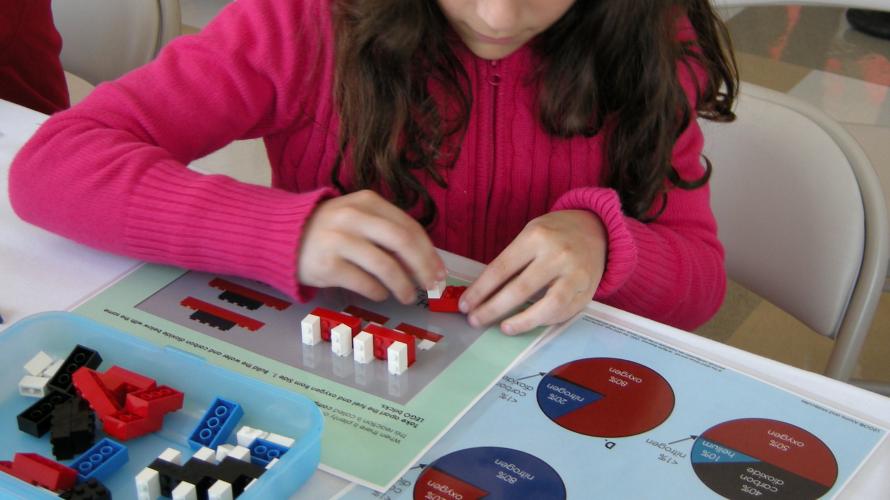Using LEGO bricks as atoms, the students build a model of air as a mixture. Students also model combustion to produce carbon dioxide and air pollutants.
Understanding Air
This lesson is appropriate for children ages 11 and up. Understanding Air emphasizes the molecular composition of air. Using LEGO® bricks as atoms, the students build a model of air and then combust fuel models to produce additional carbon dioxide and air pollutants.
Download the Molecule Sets Overview or read the Rationale for using LEGO bricks as atoms.
MIT Edgerton Center Teacher Guides, Resources, and Training:
- Teacher Guide for Understanding Air (Google Slides)
- About the Curriculum
- Assembling a Molecule Set
- Teacher Training
- Lesson Preparation
- Classroom Presentation
- Partners in Public Health webinar presentation by Kathleen Vandiver on the Atoms and Molecules set, with a focus on the Understanding Air lesson
- STEM Project for creating an Arduino Particle Meter
5. Recognize that there are more than 100 elements that combine in a multitude of ways to produce compounds that make up all of the living and nonliving things that we encounter.
6. Differentiate between an atom (the smallest unit of an element that maintains the characteristics of that element) and a molecule (the smallest unit of a compound that maintains the characteristics of that compound).
7. Give basic examples of elements and compounds.
8. Differentiate between mixtures and pure substances.
Central Concepts: Energy resources are used to sustain human civilization. The amount and accessibility of these resources influence their use and their impact on the environment. 2.1 Recognize, describe, and compare renewable energy resources (e.g., solar, wind, water, biomass) and nonrenewable energy resources (e.g., fossil fuels, nuclear energy).
2.2 Describe the effects on the environment.
Next Generation Science Standards:
MS-ESS3.D.1
Human activities, such as the release of greenhouse gases from burning fossil fuels, are major factors in the current rise in Earth’s mean surface temperature (global warming). Reducing the level of climate change and reducing human vulnerability to whatever climate changes do occur depend on the understanding of climate science, engineering capabilities, and other kinds of knowledge, such as understanding of human behavior and on applying that knowledge wisely in decisions and activities.
MS-PS1.B.1
Substances react chemically in characteristic ways. In a chemical process, the atoms that make up the original substances are regrouped into different molecules, and these new substances have different properties from those of the reactants.
Understanding Air is excellent for booths at public STEM events, festivals, or fairs. Below is a collection of the materials and instructions necessary to create your own booth with different stations.
Instructions:
- Guide for Using Understanding Air for Public STEM Events
- Booth Setup Instructions
- Station Volunteer Instructions
- Station LEGO Layout Cards (includes lists of bricks)
Mats:
- Atom Key/Layout Mat
- What Is Air Made Of Mat
- Burning Fuel: Complete Combustion Mat
- Burning Fuel: Incomplete Combustion Mat
- Air Chemistry and Pollution Mat
- CO2 Graph







